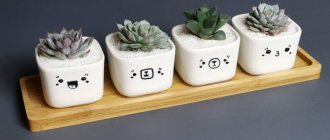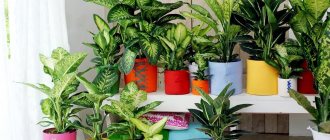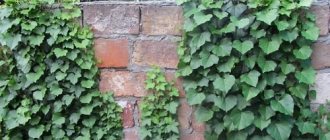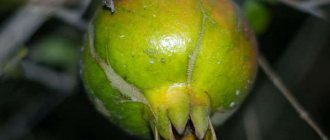An evergreen exotic stem can exist for a long time at home. With proper care, the bamboo indoor plant will bloom with beautiful small flowers. The frequency and size of the color depends on the species. Any of them can be grown in soil or placed in water. You can make it even more decorative if you twist the elastic stems in time by fixing them on a guide object, by limiting the space. Green shoots look good alone and in compositions.
About the plant
Another name for decorative bamboo is Dracaena Sander. In the 19th century, it was brought from China by the English florist Frederick Sander. The plant has a bare stem with lanceolate leaves at the top. The greenery quickly increases in size. After a few months, even dwarf varieties can reach 1 meter in height.
Indoor bamboo is used for decorative purposes. It will fit perfectly into any interior and will be an original decoration for a residential or office space. The ability of the stems to twist in different directions gives designers the opportunity to imagine in any direction, creating original compositions.
Bamboo indoor plant care at home: what it looks like
bamboo spiral
The plant has a bare stem, which has green leaves at the end. At home, on the windowsill, the created composition with bamboo in a vase will look very exotic. The color of the stems can be either emerald green or straw yellow. But the leaves and shoots will have a more intense color only if good lighting is provided throughout the day.
Bamboo stems have amazing flexibility, they are able to twist into a variety of spiral shapes, it is this feature that makes the plant suitable for creating bonsai. Unfortunately, the flowering of Dracaena Sander at home is extremely rare.
Species diversity of indoor pets
Especially noteworthy are several types of indoor bamboo, which have gained the greatest popularity among plant lovers. Each of them has an individual shape and color of leaves, as well as a different shape of stems. The most famous and suitable for growing at home include the following.
Lucky Bamboo
The main one has a beautiful name - bamboo Lucky spiral care at home is simpler than the others, but gardeners call it a little more simply - Sander's dracaena.
This plant can be classified as a species that is less demanding of care, but at the same time requires constant provision of a special microclimate. Dracaena does not complain about infrequent watering and dry soil, but rather welcomes it. Most often the plant is used as a landscaping area in a room or as part of an interior design.
Reproduction occurs by seed or using cuttings, due to the lack of root layering. Initially, Lucky's appearance is straight, but it is forced into a spiral one.
Bamboo Muriel
The largest indoor specimen with a stem height of about 2.5 meters is from the Muriel variety. This type is an excellent solution for a large room or growing in the garden. The plant gets along very well with any frame, but due to its enormous size, care is very difficult, especially if it is done by one person.
Variegated
Variegated bamboo has achieved the greatest decorative value, and all thanks to its crown with unusual colors.
The leaves are slightly colored light green, and the edges are decorated with small white inclusions.
The stem has a green-yellow color;
it is interesting that by the time it is transplanted to a new place, it is covered with snow-white spots.
There is one significant drawback: the plant quickly becomes unattractive due to the drying out of the foliage in combination with the active change of the crown.
In addition to these representatives, in the indoor version there are:
- Multilayered with narrow foliage
- Bluish or short, growing in miniature sizes, which rarely exceed the 40 cm mark
- Variegated with decorative foliage, has an average height of up to 1 meter
- The brilliant variety appears as bright emerald green with narrow leaves.
Varieties for open ground in Russia
How is bamboo grown in open ground in Russia? For moderate climatic regions of the Russian Federation, only frost-resistant species that can be planted in open ground are suitable. The Chinese phylloblast (sinarundinaria pleioblastus photo) will not like such conditions. The plant will be able to withstand short periods of frost down to -20 °C. If the indicator becomes lower, the plant will freeze to the ground level. In some areas, the earthen layer often freezes, in which case the phyloblast will die from frostbite. The ideal temperature for the species is +30 -9 degrees.
Several species can be grown in the Moscow region, called Saza bamboo (Sasa tsuboiana). Their beauty is no worse than that of the southern varieties and there is no compromise in height: they range from 30 cm to 3 meters.
Tree of happiness, bringing prosperity to the home care video:
Types and varieties
Indoor bamboo is a miniature plant. It is grown at home in pots with soil or special transparent containers covered with pebbles and filled with water. Bamboo care is minimal. The plant requires lighting, watering and periodic feeding. All varieties have a hollow stem in common. Various species are classified by size and are divided into the following groups:
- Low. Plants grow up to 1 meter. Popular varieties are “Golden Lily”, “Tsuboi”;
- Average. Reach 3.5 meters in height. Beautiful varieties - “Shiroshima”, “Mexican weeping”;
- Tall. A rarity for interiors, as they stretch up to 6 meters. Bright representatives of the group, similar to giants, are “Tropical Black”, “Monastic”.
When choosing a variety, you must clearly understand the purpose of planting. It is necessary to take into account the height of the plant and how it will look, the shape of the leaves, and the type of root system. For some species, solitary existence is more suitable, while others feel better in groups.
The magical properties of indoor bamboo
How to grow indoor fern - care at home
In the East, this plant is believed to bring good luck. Thanks to this belief, it spread to Russia. In addition, many believe that indoor bamboo helps restore energy balance and harmony in the home. The presence of this plant attracts money, happiness to the house and ensures peace and mutual understanding in the family.
Bamboo at home
The indoor plant bamboo occupies an important place in Feng Shui practices. Placing it in the south-eastern part of your office or home will ensure business success. The effect of the flower can be increased if you place a three-toed toad next to it - a magical symbol of wealth in Feng Shui.
Conditions for keeping the plant
It is very easy to create comfortable living conditions for bamboo. Houseplants need good lighting and fresh air. The shoots receive nutrition through the root system, so systematic watering and fertilizing are important. Depending on the type of planting (soil or water), certain care rules apply.
Lighting and location
Indoor bamboo does not tolerate direct sunlight. The place must be chosen to be bright, but with dosed penetration of ultraviolet radiation. Darkening in the midday heat can be achieved with the help of a curtain. In regions with prevailing cloudy weather, during periods of decreasing daylight hours, plants can be artificially illuminated with special lamps. Lack of light affects the appearance of greenery - the foliage falls off, the trunk turns yellow, and growth slows down sharply.
It is better to place a pot of bamboo on a western or eastern window sill. It should not be allowed to overcool, so in winter it is better to move the container to the center of the room and carefully ventilate it.
Air temperature and humidity
As the seasons change, the temperature preferences of indoor bamboo change. Elevated values for it are equally destructive as low ones. To maintain a good humidity regime, the temperature in summer should not exceed 35 °C, in winter – 15 °C. If the room is very hot, the pot with the plant should be temporarily moved to a room without windows (hallway, bathroom). Optimal temperature indicators are 25-30 °C.
Humidity is not very important for plant development. But since dracaena is a tropical plant, too dry air can harm it. You should not use a spray bottle to spray the foliage; oversaturation with liquid will lead to rotting of the stem. If the air is warm and dry, you can place a plate of water next to the bamboo. Regularly wiping the leaves with a damp cloth will do more good than watering on a hot day.
Lighting, humidity and temperature
Proper lighting is important for any plant. Bamboo, like other dracaenas, loves bright rooms, but direct sunlight will not benefit the plant. Direct sun may cause burns on the leaves. The flower will feel good in diffused sunlight. It will grow in partial shade, but insufficient lighting inhibits growth, and in this case the leaves may turn pale.
Bamboo is a tropical plant, so dry air is unacceptable for it. To humidify the air around the plant, you can place containers of water nearby, or use a special humidifier. The flower will also appreciate daily spraying.
Homemade bamboo loves warmth very much. In an ordinary apartment he will be quite comfortable, you just need to make sure that the air temperature does not drop below 20 degrees. The room where the plant is located can, and even should, be ventilated, but bamboo does not like drafts.
Thus, if you follow the conditions of keeping the plant, then planting bamboo, as described above, will not be difficult, because the plant will be healthy and strong.
Choosing a container for planting
The pot must match the size of the bamboo and the number of its stems. The shoots must be at least 5 cm from the edge of the container. It is not necessary to place them strictly in the center. Any flower pot with drainage holes is suitable for planting in the ground. If you decide to grow a plant in ordinary water or hydrogel, it is better to use a beautiful transparent vase. You can hide the root system with the help of beads and pebbles.
The recess of the container should be twice the size of the rhizome. A flat, small flowerpot will not work. Plants planted in water will have to be pruned periodically, since the root system is branched and grows quickly. Each grower chooses the growing method for himself, having previously assessed the pros and cons of each option.
How to grow bamboo at home?
The tree of luck is an amazing plant; for its successful maintenance, you can use not only flower pots, but also an aquatic environment. While the initial stage of growth is in progress, the stem can be given any desired shape. What methods of cultivation exist, and what are their features?
Use of the aquatic environment
The homeland is located in tropical forests, and there are not many dry places here, which is why some plants moved into the water.
How to care for bamboo in water? To create conditions as close to natural as possible, a special environment is created for the plant.
Before planting, the root part is washed; if necessary, shoots that are too long can be trimmed. They cut down to a third of the entire rhizome, and this will not harm it, because the growth rate of bamboo is impressive.
Any suitable item at the discretion of the gardener will be suitable as a container. You can use decorative stones to make the display more interesting, but before doing this, do not forget to treat them with boiling water. The stem parts are lowered into the selected container, the pebbles are carefully laid out, then it is the turn of the main component - water.
Note to plant lovers . This method of cultivation involves the use of distilled or melt water. There shouldn't be any problem with the last component. Water is poured into a plastic bottle and sent to the freezer. When defrosting, it is recommended to throw away the frosted core of the ice where all sorts of harmful components settle along with chlorine.
When caring for a plant, the water should be changed systematically; most often, this procedure is carried out once every 14 days. If an unpleasant odor, bubbles, foam, or sediment begins to appear, then the fluid needs to be changed more often. The presence of yellow foliage is an indicator for immediate water replacement.
It is worth considering that with this specific method of cultivation, plants need fertilizing, which is applied once every 30 days.
Using hydrogel
The procedure is similar to that described above, but here they use granules rather than stones.
How does bamboo grow in hydrogel? It has a specific feature: after some time it changes color, all you need is to systematically add a certain amount of water. Fertilizing is applied twice a year.
It is important not to forget about the root system; it should not dry out or be exposed and protruding above the granules.
Of course, such an original method of growing will be a highlight in the overall interior of the room.
Application of soil
This method can be considered traditional. Finding the soil you need for bamboo is easy; specialized stores offer a huge range of different soils that are suitable for dracaena. You can prepare the soil with your own hands, taking into account some important aspects.
Potted bamboo should develop along with a good drainage system to prevent possible:
- mold formation
- accumulation of excess moisture
- the appearance of hostile microorganisms
You can plant several stems of bamboo dracaena in one container with soil. To make it more convenient to care for them, as well as to give them a more decorative look, it is recommended to tie several plants into a bundle with braid rope, choosing the color you like. Any container will fit under the pot, not just traditional devices. Some people use glasses and vases. As soon as the pet begins to “outgrow” its house, it is transplanted into a bucket or deep jug. If the height of the plant exceeds 0.8 meters, it is recommended to move the container with it from the surface to the floor in the immediate vicinity of a window opening or next to a light source.
Subtleties of care
- To successfully grow bamboo in an apartment, you need to choose a place where light and shadow will be optimally combined. Excessive lighting will lead to lush growth of greenery and frequent pruning will be necessary; moreover, dense shade affects the health of the stems.
- With excessive care and frequent fertilizing, bamboo can begin to bloom, and this is a sign that it will soon die. In the wild, the plant begins to produce flowers from the age of 30, and then it begins to die off. The flowers are white in color and have a delicate aroma.
- Trimming creates a million possibilities to create any shape. When the top part is cut off, growth stops and foliage begins to grow denser, which affects the overall outline of the plant. It is necessary to trim the shoots above the node at a distance of at least 5 cm.
- It is necessary to observe the timing of transplantation, otherwise the pet will shed its foliage.
- With the onset of summer, it is recommended to expose dracaena to fresh air, which any plant needs.
- To create an ideal microclimate, you should use humidifiers. If such devices are not available, spray bottles are used. Spraying is carried out once every few days. If necessary, the leaves can be wiped with a cloth soaked in water.
Transplant Basics
It is important to know! Bamboo is very painful to transplant, and therefore if there are no important prerequisites for this procedure, then you should refrain from it.
First of all, the required capacity is selected.
There should be some space left for the root system, but not very much. The ideal option is if the rhizome easily enters the pot and leaves 4 cm of free space. Secondly, drainage holes are made if there are none. Install a drip pan to allow excess liquid to accumulate. A layer of drainage is placed along the bottom of the pot.
After these manipulations, the dracaena is planted in a container and filled with soil; it does not need to be thoroughly compacted; if necessary, you can simply add more soil. The plant in a new location must be watered properly; sufficient time is given to the transplantation procedure. Excess water is poured out of the pan, after which the pot with bamboo is moved to the place designated for cultivation.
How to trim
bamboo pruning
This procedure is carried out if it is needed to create an attractive appearance or provide the desired shape. The owner must pay enough attention to the root system to remove defective, dry shoots.
To create a bushy type, it is recommended to get rid of the upper shoots in the place where they branch.
Trimming branches from below and removing sections of insufficient thickness will help maintain decorative appeal. It is possible to give a certain shape to the stems only while the plant is still a seedling; garden twine or thick wire is used for garter.
It is recommended to dip the cut shoots in melted paraffin, as it preserves the cuts and prevents infection.
Growing in soil
The option of growing in the ground is more preferable for dracaenas. Water does not linger for long, which prevents root rotting. Any soil mixture for indoor plants, consisting of clay turf, peat, and humus, is suitable. There must be a drainage layer - 5-6 cm of sand, small pebbles. After planting in the ground, the plant is watered and placed in partial shade for several days.
Bamboo grown with a closed root system must be fertilized. In spring and autumn, complex lawn mixtures saturated with nitrogen are used. The first flower transplant is carried out after 2 years. Then only the top layer of soil is replaced. A shallow cut at the bottom of the stem will help stimulate root development.
Each time you replant, you must carefully inspect the bamboo roots. Rotten, old and damaged ones should be removed.
How to replant bamboo
Repotting is one of the most important aspects of caring for indoor plants. Therefore, if it is planned immediately after purchasing a flowerpot with a flower in a store, it is initially necessary to give the plant time to acclimatize.
To do this, it is kept in room conditions for 7 to 10 days. Only after such preparation, replanting indoor bamboo will not be too stressful for the flower and will not lead to its death.
Mature bamboo
Key points about replanting decorative bamboo:
- Selection of flowerpot
- Selection of soil mixture
- Drainage preparation
- Purchasing a root stimulator
The best option would be a ceramic or clay pot with drainage holes.
The diameter of the new flower pot should be slightly larger than the previous one. A water tray is required.
Can bamboo be planted in the ground? What kind of soil is needed for bamboo? Selecting soil for bamboo will not be difficult. To plant it, you can use ready-made soil mixtures for palm trees, dracaena and ferns.
You can also prepare the soil substrate yourself. To do this, turf, clay soil, peat and humus are combined in a ratio of 2:2:1:1.
Bamboo grows well in moist soil, but does not like stagnant water and poor soil aeration. Therefore, a layer of drainage must be poured onto the bottom of the flowerpot. You can use pebbles or clay shards as it.
Using a root formation stimulator will allow the plant to quickly take root in a new location. In addition to stimulating the growth of the root system, these drugs contain active substances that prevent the development of fungal and viral infections.
This allows the transplanted bamboo to quickly adapt to new conditions. Also, plants that were transplanted with root formation stimulants develop better and are highly resistant to diseases and pests.
It is recommended to replant decorative bamboo in early spring. The frequency of replanting young plants is annually, adults - once every three years.
In stores, this plant is often offered in the form of stems growing in water or hydrogel. Young shoots can be replanted only after the roots reach a length of 5-6 cm. If the size is smaller, the bamboo may not take root.
If the stems are placed in hydrogel, they must be carefully removed and washed with water at room temperature. If the root system is very dense, it is recommended to shorten the roots to 7-9 cm.
This is necessary so that when planting they do not break off at the base.
Proper preparation is the key to a successful transplant. Therefore, following all the recommendations, replanting indoor bamboo yourself will not be difficult.
Growing bamboo in water
For a long and trouble-free existence of bamboo in a liquid environment, simply placing it in water is not enough. An unpretentious plant will need to create optimal conditions for rapid growth. By doing group plantings, you can create your own tropical garden in a short time. The original method of growing will give the best result - a strong trunk, lush greenery, if planting bamboo in the house is carried out according to the following plan:
- The root system is inspected, overgrown, weak roots are removed. You can safely cut off up to 1/3 of the base;
- Select a container. It should be a low, wide vase. A transparent glass with decorative natural stones looks beautiful;
- The decor and container must be boiled in water before use;
- The bamboo stem is lowered into a vase, the roots are carefully leveled and fixed with decor;
- Fill the plant with filtered, settled water 2 cm above the stones;
- The fluid must be changed at least once every two weeks. The first signs that the water requires replacement are a musty smell, bubbly, cloudiness, and the appearance of foam;
- When watering every month, bamboo is fed with phosphorus, nitrogen fertilizers and their varieties.
How to properly care for a plant
Growing bamboo at home is not easy, despite its love of moisture and rapid growth in favorable conditions. Creating such an environment will require constant attention, the availability of prepared water, and certain skills in floriculture. A unique green perennial will be an excellent decoration for a house or apartment if you provide it with suitable growth conditions - choose the right location, moisten it in a timely manner, prune it, protect it from pests and diseases, and properly care for it.
The soil
You can use any soil for bamboo. A simple mixture of lawn soil and sand will do. But it is better if the soil is acidic, slightly acidic. Heavy soil contributes to root rot and slower growth. Broken shards, expanded clay, and small pieces of brick can serve as drainage. The bottom layer should occupy 25% of the capacity.
The plant is placed in the center of the pot, the roots are lowered onto the drainage. After filling the soil, it should be lightly pressed down to release the air. The soil should always be moist. The top layer is checked by touch daily and loosened once a week.
Watering
It is necessary to moisten the soil only with warm rain, settled water. Regular tap water contains many impurities harmful to plants, which accumulate in the roots and slow down natural processes - photosynthesis worsens, leaves turn pale and become deformed. At such moments, the plant is susceptible to attacks by parasites and loses immunity to many diseases. If it is not possible to collect or filter the liquid, you can soften it by freezing. Water is poured into a plastic bottle and placed in the freezer. After thawing, it becomes suitable for watering.
The frequency of watering bamboo palms depends on the time of year. In spring and summer, moisture should be plentiful, in autumn and winter - moderate. With the arrival of cold weather, the plant can be transferred to independent control of its moisture needs by transplanting it into a vase with water.
It is recommended to water bamboo through a tray. The roots of the plant absorb liquid according to their needs. After a few hours, the water is poured out of the pan. The procedure is repeated when the top layer of soil is completely dry. Do not use a spray bottle or water at the root. Such methods of moistening can lead to the formation of rot on the roots.
Watering should be stopped if the soil begins to emit a putrid odor. If the top layer of soil is covered with a gray or white coating, it must be replaced, the bamboo roots must be washed and disinfected.
Transfer
The hardest and fastest growing grass can be replanted when it has sufficiently developed the root system, up to 4-5 cm. To do this, the cuttings are placed in water and left in a lighted place. Roots that are too long must be shortened to at least 7 cm, otherwise they may get tangled and break at the very base. The transplant procedure is as follows:
- Just before planting, the cuttings are removed from the germination medium, and the still wet roots are treated with a rooting agent;
- Lower the sprout into the hole or onto the drainage, add portions and compact the soil along with the mixture for root growth;
- The soil should reach the top edge of the pot; if it settles during watering, it should be added.
It is better to replant bamboo in early spring, so that the root system has time to strengthen and its leaves do not fall off with the arrival of cold weather. The pot should be deeper and wider than the previous one. During the growth period, the plant should not have its roots in contact with the walls of the container.
Throughout the growing season, bamboo can be replanted several times. The movement is facilitated by rapid growth and the desire to propagate the plant.
Feeding and fertilizers
Indoor bamboo grows much better in a nutrient medium, although it can remain in ordinary water for a long time, content only with its renewal. The main thing when working with fertilizers is not to overdo it. An abundance of nutrients, especially in the first weeks after transplantation, will only cause harm.
All ground types of bamboo are strengthened once a month, starting in spring. In the summer, during the period of active growth, the dosage can be reduced and the time interval between approaches shortened. You can use universal fertilizers specifically designed for palm trees or decorative deciduous perennials.
A herbaceous plant growing in water must be fertilized regularly, even in winter, since such an environment contains much less nutrients than soil. For this purpose, liquid compositions based on nitrogen and phosphorus are used. The recommended dose on the package must be reduced by at least 5 times so as not to provoke rapid growth. You can also use foliar fertilizers instead of root fertilizers, strictly following the spraying rules.
Bamboo trimming
Bamboo can be shaped into any shape. A flexible, unpretentious plant tolerates pruning well with good rooting and in the absence of the slightest disease. First of all, get rid of dry excess stems located at the base of the plant. Then select a branching point, if necessary, connect the shoots with tape, cut off below the marked node. Such herbaceous specimens will no longer grow upward.
For beautiful vertical growth, you need to regularly prune the branches. Thinning is necessary for both straight and spiral varieties of lacbamboo. The cut areas are sprinkled with ash or lubricated with wax. Cuttings are used for rooting. Small cuts in the lower part of the stem will help speed up the process of root emergence.
Caring for bamboo at home
Growing bamboo at home is not difficult. Technologies differ depending on whether it grows in water or soil. Some varieties are grown both ways.
Temperature
The flower grows best at temperatures from 18 to 25 degrees Celsius. The plant tolerates hot weather easily. Most varieties have good frost resistance, but it is not recommended to overcool the plant.
Lighting
Optimal for the plant is diffused light. It is usually created using a curtain or curtain. A lack of light will cause the flower to turn yellow and its leaves to fall off, which will negatively affect its appearance and decorative properties.
Bamboo care
Watering
It is recommended to water the plant only with settled rainwater. In spring and summer, a lot of moisture is required. Plants with wide leaves need to be watered 2 times a week, those with narrow leaves - at least once every two days. In winter and autumn, the frequency of watering should be significantly reduced (up to once a week).
Important! Tap water is not suitable for irrigation. It contains a large number of various harmful impurities. They have a negative impact on photosynthesis processes. The plant will begin to turn yellow, lose leaves, and become susceptible to various diseases and insect attacks.
Spraying
Professional flower growers recommend spraying the plant 2 times a week. This allows you to maintain a natural level of humidity. In addition, this is an element of hygiene. Wiping and spraying the leaves protects the grass from pests.
Humidity
Most varieties are unpretentious to the level of humidity in the room. They grow equally well in conditions of normal and low humidity. Some varieties require the creation of a special microclimate in the room.
Growing bamboo in soil
The plant can be grown well in soil. Any mixture for growing bamboo is suitable; the plant does not have any special requirements for the soil. It requires timely and good watering, as well as periodic feeding. Regular soil changes may not be necessary.
Growing bamboo in water
A special feature of the plant is that it can be planted in water. This technology is simple, but requires compliance with some rules:
- The water should be soft. Usually either rainwater or melt water is used.
Note! You can prepare melt water yourself. To do this, fill a container with tap water, freeze until it becomes ice, then defrost. All harmful impurities and bacteria will die after such treatment.
Bamboo in water
- The water in the container should be changed at least once a week.
- It is necessary to regularly fertilize the water.
- The container in which to plant a flower can be anything: a flower pot, a vase or a simple jar.
- The vessel must be placed in a well-lit place.
Feeding
The frequency of fertilization depends on the growing method. When cultivating a plant in water, it should be fed once a week at the time of changing the water (you can use a hydrogel, which will simplify care). If the soil growing method is chosen, it is recommended to apply fertilizers once every 2-3 months. Special mineral mixtures for dracaenas should be used.
Bamboo trimming
This procedure is very important for the formation of a decorative form. Another reason to prune bamboo is for flowering. Immediately after it finishes blooming, the plant will dry out. It is necessary to trim the flower in a certain sequence:
- Removing dry branches;
- Trimming excess shoots;
- Removing unsightly stems and those that have grown above the desired height.
The cutting area must be treated with a special varnish, otherwise unsightly growths may form there or pests may appear there.
Transfer
To ensure a comfortable microclimate and growth for young bamboo, it is recommended to plant it. This should be done annually. To replant a bush, you need to prepare the soil. It is enough to mix ½ part of turf soil with equal parts of leaf soil and peat.
Bamboo propagation methods
There are several ways to get several plants from one stem of Dracaena Sandera. It is necessary to choose the optimal method of propagation at home after assessing many factors that may influence the further processes of bamboo development. It is necessary to take into account the humidity in the room, temperature, lighting. Most often, cuttings are separated from a healthy plant during transplantation, but seeds can also be used. Each option has its own characteristics.
Propagation by cuttings
The most popular method of propagating bamboo. It is often used at home because it requires minimal effort to implement. For an exotic plant, this is the best option. There are several options for cutting bamboo:
- Apical. To obtain suitable cuttings, the top of the mother plant is cut off. The segment must be at least 15 cm long. Then the cutting is placed in water and a root stimulator is added. To prevent part of the stem from rotting during the process of root growth, all cut areas are lubricated with liquid wax.
- Stem. Rooting occurs using the standard method in water with a solution of a growth stimulator. The mother plant is divided into parts and each section is processed. The method is relevant if the top has not taken root, has rotted, or is affected by diseases or pests.
- Reproduction by knees. The method is rarely used in floriculture, but this does not make it less effective. Use knee propagation if it is necessary to save an old, weakened plant. Roots on the stem grow at the junction of the segments. They are separated, rooted and buried in the ground.
Seeds
Growing bamboo from seeds is not an easy task and requires a lot of time and effort. At home, this method of reproduction is practically not used. From planting to emergence of seedlings it will take at least 2 weeks.
Before transferring seeds into the soil, they should be soaked in purified water for a day. This time is enough for the embryo to wake up inside. They are planted in a special substrate made from surface soil, ash, and wood shavings. All components must be mixed and sifted to remove debris and small stones.
The first planting of soaked seeds is done in a large, solid container. They are placed one at a time to a depth of 2-5 mm, covered with earth without compacting. Seedlings need fresh air, dosed sunlight, and daily watering.
The peculiarity of bamboo seeds is the initial formation of the root, not the sprout. A few months later, as soon as the first shoots form, the plants are planted in pots in a peat mixture.
Characteristics of bamboo and species diversity
Dracaena Sandera is an evergreen herbaceous perennial belonging to the genus Dracaena, family Asparagus. The hot African tropics are considered the birthplace of the flower. In its natural environment, the height of the plant reaches several meters. At home, the flower grows no more than 70-80 cm.
The stems are very similar to the trunks of real bamboo. They are bare and segmented. The stems have a bright light green color. Occasionally you can find dracaenas with dark green trunks.
The leaves are lanceolate in shape. They reach 25 cm in length and 3 cm in width. The texture of the plates is dense. The surface is glossy, as if covered with a thick layer of varnish. Dracaenas with light green stems have leaves of the same color. In rare dark green varieties they have a two-color color: on the dark green background of the plates there are white and yellow longitudinal stripes.
It may seem incredible, but Lucky Bamboo is a flowering plant. Even very experienced gardeners find it difficult to imagine bamboo flowering, since this happens extremely rarely. Only once in its entire life can it release a flower-bearing arrow with small white flowers collected in panicle inflorescences. Witnesses of this rare event note the pleasant aroma emanating from the flowers. Unfortunately, flowering does not benefit the dracaena. As a rule, after this she dies.
Blooming Dracaena Sandera
Indoor flowers are actively used by designers as an element of room decor. Moreover, it fits equally harmoniously into the interior of both a cold office and a cozy bedroom. Often, the trunk of a plant is given a spiral or other unusual shape to increase its decorative value.
Features of care in winter
With the onset of cold weather, the plant slows down its growth and enters a dormant state. During this period, it is necessary to make certain changes in care. First of all, reduce watering. Now you need to moisten the soil once a week, combining the procedure with wiping the leaves and spraying.
It is necessary to install the plant for wintering in a warm place where the temperature does not fall below +18 ° C and the humidity is below 40%. Using a special lamp you can organize additional lighting. In winter, it is better not to loosen the soil or do it very rarely.
Diseases and pests
Bamboo has good immunity to diseases, so the most common problem is the formation of yellow leaves and dullness of the stem. Often the cause of color loss is poor quality care. Strong and constant lighting, watering with dirty tap water, and insufficient drainage can cause harm to the plant and lead to similar consequences. Excessive moisture will cause rot, fungus, and bacterial development.
If you find even small spots on the leaves, they need to be cut off. After drying, the removal sites are treated with charcoal, and a few hours after disinfection, they are covered with wax.
Pests rarely attack indoor bamboo. But, like all house flowers, spider mites can be found on Dracaena Sandera. Treating all areas with a soap solution will rid the plant of insects.
Bamboo in the house: signs, superstitions and Feng Shui
All signs associated with bamboo in the house are exclusively positive. A persistent, hardy plant has a beneficial effect on human life. It is given and accepted as a gift with the desire to improve well-being, attract good luck, and harmonize all life processes. According to legend, each section of bamboo is responsible for a certain stage in life.
A plant with powerful energy can either improve or worsen the situation in the house, so you should know the rules for its location. By placing the “tree of happiness” in a certain place in the house, you can adjust the necessary areas of life. According to the Chinese teachings of Feng Shui, the number of stems is of great importance. They have the following effects:
- 2 stems - a symbol of love and a strong marriage;
- 3 – family well-being, happiness;
- 4 – a symbol of death, you cannot keep such compositions at home and present them to friends;
- 5 – wealth, financial success;
- 7 – improvement of well-being, strengthening of health;
- 8 – success in any endeavor;
- 9 – successful job, career growth;
- 20 – “Tower of Love” will strengthen friendship, renew love, warm family relationships.
What you didn't know about indoor bamboo
There have been changes in the names of bamboo varieties recently, which leads to some confusion among those gardeners who know their previous names. A comparative list of these changes would be useful.
| New name: | Old name: |
| Bashania fargesii | Arundinaria fargesii |
| Pseudosasa japonica | A. japonica |
| Fargesia murienaliae | A. murienaliae |
| F. nitida | A.nitida |
| F. palmata | A. palmata |
| Pleoblastus pygmaeus | A. pygmaea |
| P. variegatus | A. variegata |
| P. auricomus | A. viridistriata |
| Indocalamus tessellatus | Sasa tessellata |
Bamboo growing in containers can be transplanted into open ground at any season, not coinciding with frosts and droughts, in places protected from direct cold winds; be sure to mulch the root zone to preserve moisture.
A clump of bamboo planted in a spacious and large pot looks picturesque on a balcony or in a patio with normal, regular watering, for which the short and cold-resistant species Shibatea kumasasa is most suitable.
If you want to grow taller bamboo (Fargesia murienaliae or F. nitida) in a pot, you will need not only a large pot, but also one that is heavy enough so that it will not be knocked over by the wind, but this is due to the need to replant the bamboos into a larger pot each year, since they are quite grow quickly.
Bamboo growing in a pot on the balcony can be left there in winter, covering its soil layer with a thick layer of straw and wrapping the entire curtain with the pot in several layers of polyethylene, loosely tying it with a rope to the very top.











